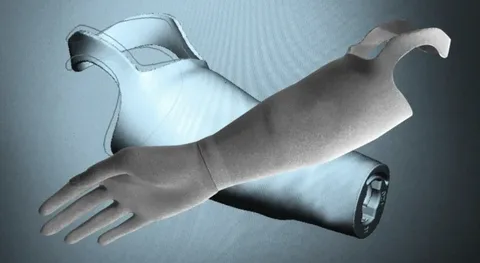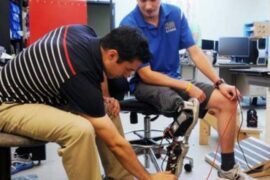Introduction
The field of prosthetics has undergone significant advancements over the past few decades, leading to the development of more durable, flexible, and patient-friendly devices. Among the many materials used in the creation of prosthetics, Chlorinated Polyethylene (CPE) has emerged as a critical component.
This versatile polymer has found numerous applications in the medical industry, particularly in the manufacturing of prosthetic devices. Its unique properties make it ideal for use in medical devices where flexibility, chemical resistance, and durability are of paramount importance.
This post will delve into the intricacies of Chlorinated Polyethylene, exploring its manufacturing process, and examining its various applications in the field of prosthetics. We will analyze why this material has become so vital in medical devices and how it continues to shape the future of prosthetics.

The Manufacturing Process of Chlorinated Polyethylene
Understanding the Basics of Chlorinated Polyethylene
Chlorinated Polyethylene (CPE) is a synthetic polymer derived from the chlorination of polyethylene. This process involves the substitution of hydrogen atoms in polyethylene with chlorine atoms, which significantly alters the material’s properties.
CPE is known for its high resistance to heat, oils, chemicals, and weather, making it an ideal candidate for a variety of industrial applications, including medical devices.
Steps Involved in the Manufacturing Process
The manufacturing process of Chlorinated Polyethylene begins with the chlorination of high-density polyethylene (HDPE) or low-density polyethylene (LDPE) under controlled conditions. The process typically involves the following steps:
- Selection of Base Polyethylene: The process begins with the selection of the appropriate type of polyethylene, which could be HDPE or LDPE, depending on the desired properties of the final product.
- Chlorination Reaction: The selected polyethylene is subjected to chlorination, where chlorine gas is introduced into the polymer under controlled temperatures and pressures. The degree of chlorination is carefully monitored, as it directly influences the final properties of CPE.
- Control of Reaction Parameters: The reaction parameters such as temperature, pressure, and the concentration of chlorine gas are meticulously controlled to achieve the desired level of chlorination. The degree of chlorination can range from 25% to 45%, depending on the application.
- Post-Chlorination Processing: After the chlorination reaction, the polymer is washed, neutralized, and dried to remove any residual chlorine and reaction byproducts. This step ensures the purity and stability of the final CPE product.
- Pelletization and Compounding: The processed CPE is then pelletized and may undergo additional compounding with additives such as stabilizers, plasticizers, and impact modifiers to enhance its properties for specific applications.
Quality Control and Standards
The manufacturing process of Chlorinated Polyethylene must adhere to strict quality control standards to ensure that the material meets the necessary specifications for medical applications.
This includes rigorous testing for chemical composition, mechanical properties, and thermal stability. The quality of CPE used in prosthetics is crucial as it directly impacts the performance and safety of the medical devices.
Applications in Prosthetics
Why Chlorinated Polyethylene is Ideal for Prosthetics
The use of Chlorinated Polyethylene in prosthetics is driven by its unique combination of properties that make it suitable for a wide range of medical applications. Here are some of the reasons why CPE is highly valued in the production of prosthetics:
- Flexibility and Elasticity: CPE exhibits excellent flexibility and elasticity, which are essential characteristics for prosthetic devices that must mimic the natural movement of the human body.
- Chemical Resistance: Prosthetic devices often come into contact with various chemicals, including body fluids, cleaning agents, and disinfectants. CPE’s resistance to a wide range of chemicals ensures the longevity and durability of the prosthetics.
- Weather and UV Resistance: CPE is highly resistant to weathering and ultraviolet (UV) radiation, making it ideal for prosthetics that may be exposed to outdoor environments.
- Biocompatibility: For medical applications, biocompatibility is a critical factor. CPE is known for its low toxicity and minimal adverse reactions when in contact with human tissue, making it a safe choice for prosthetic components.
Specific Applications in Prosthetics
Chlorinated Polyethylene is used in various components of prosthetic devices due to its versatility. Some specific applications include:
- Socket Liners: The socket liner is a crucial part of a prosthetic limb that interfaces with the patient’s residual limb. CPE’s flexibility and comfort make it an ideal material for socket liners, providing a soft yet durable interface.
- Prosthetic Joints: CPE is used in the manufacturing of prosthetic joints due to its ability to absorb impact and reduce friction, thereby enhancing the movement and functionality of the prosthetic limb.
- Protective Coatings: CPE is often used as a protective coating for prosthetic components, providing an additional layer of chemical and weather resistance, which helps in extending the lifespan of the devices.
- Orthopedic Braces: Beyond limb prosthetics, CPE is also utilized in the production of orthopedic braces and supports, where its flexibility and durability provide the necessary support and comfort to the patient.
Advantages of Chlorinated Polyethylene in Medical Devices
Enhancing Durability and Performance
One of the primary reasons for the widespread use of Chlorinated Polyethylene in medical devices, including prosthetics, is its ability to enhance durability and performance. CPE’s resistance to wear and tear ensures that prosthetic devices remain functional for extended periods, reducing the need for frequent replacements. This is particularly important in prosthetics, where device reliability is crucial for patient mobility and quality of life.
Cost-Effectiveness and Accessibility
Chlorinated Polyethylene is also a cost-effective material, which contributes to the overall affordability of prosthetic devices. The relatively low cost of CPE, combined with its superior properties, makes it an attractive option for manufacturers aiming to produce high-quality yet affordable prosthetics. This accessibility is crucial in ensuring that more patients have access to life-enhancing prosthetic devices.
Versatility Across Medical Applications
Beyond prosthetics, CPE’s versatility allows it to be used across a wide range of medical applications. This includes the production of medical tubing, blood bags, surgical gloves, and various other medical devices. The adaptability of CPE to different manufacturing processes and its compatibility with other materials further enhance its utility in the medical field.
Environmental Considerations
While the medical industry prioritizes patient safety and device performance, environmental considerations are increasingly becoming a factor in material selection. CPE’s recyclability and its potential for use in sustainable manufacturing processes contribute to its appeal in the medical device industry.
Manufacturers are continually exploring ways to minimize the environmental impact of prosthetic production, and CPE plays a role in these efforts.
Future Prospects of Chlorinated Polyethylene in Prosthetics
Innovations in Material Science
As material science continues to evolve, so too will the applications of Chlorinated Polyethylene in prosthetics and other medical devices. Ongoing research is focused on enhancing the properties of CPE, such as improving its strength-to-weight ratio, increasing its thermal stability, and further reducing its environmental footprint.
These innovations will likely expand the range of applications for CPE, making it an even more valuable material in the medical industry.
Potential for Customization
Advancements in manufacturing technologies, such as 3D printing and computer-aided design (CAD), are opening up new possibilities for the customization of prosthetic devices. Chlorinated Polyethylene’s adaptability to these technologies could lead to more personalized and patient-specific prosthetic solutions. This would allow for better-fitting devices that cater to the unique needs of each patient, improving comfort and functionality.
Collaboration Between Industry and Academia
The future of Chlorinated Polyethylene in prosthetics will also depend on continued collaboration between industry and academia. By working together, researchers and manufacturers can develop new formulations of CPE that address the specific challenges faced in prosthetic design and production. This collaborative approach will ensure that CPE remains at the forefront of materials used in medical devices.
Regulatory Developments
As the medical device industry is highly regulated, the future use of Chlorinated Polyethylene in prosthetics will be influenced by changes in regulatory standards.
It is essential for manufacturers to stay abreast of these developments to ensure that their products comply with the latest safety and performance requirements. Ongoing dialogue with regulatory bodies will be crucial in shaping the future landscape of prosthetic materials.
Conclusion
Chlorinated Polyethylene has established itself as a vital material in the production of prosthetics and other medical devices. Its unique combination of flexibility, durability, chemical resistance, and cost-effectiveness makes it an ideal choice for a wide range of applications.
As we look to the future, continued innovation in material science, manufacturing processes, and regulatory standards will likely expand the role of CPE in the medical field.
The potential for customization, combined with the ongoing collaboration between industry and academia, will ensure that Chlorinated Polyethylene continues to meet the evolving needs of patients and healthcare providers. As a result, CPE is poised to remain a cornerstone in the development of advanced prosthetic devices that enhance the quality of life for patients worldwide.
We invite you to share your thoughts on the use of Chlorinated Polyethylene in prosthetics. How do you see its role evolving in the future? Leave a comment below and join the discussion.





